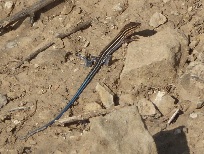Orange-Throated Whiptail (Aspidoscelis hyperythrus)
Description: A. hyperythrus has five or six light-colored stripes down a black, brown, or grey dorsal side. The middle stripe may be forked at both ends. The species is whitish-yellow or cream on the venter, and has an orange throat (females and juveniles may lack this character). Its head is yellow-brown to olive-colored, and its tongue is forked and flicked continually. It has a snout-to-vent length of 2.0–2.8 inches.
Juveniles of this species have cobalt blue legs and tails. The entire ventral surface of males, including the tail, may be orange, although gravid females may also have some orange especially lining the lower jaw. The colors are most distinct in the breeding season. Males have larger femoral pores than females.
Habitat: in southern California this lizard occurs primarily on coarse soils in open coastal sage scrub vegetation; it also inhabits many other vegetation types and disturbed areas: open chaparral, along edges of open, dry, riparian areas, along trails, along dirt roads, and in areas of light off-road vehicle use; often in areas with 50% cover and 50% bare soil, and flat to sloping topography; it seldom uses rodent burrows. The habitat has been described as washes and other sandy areas where there are rocks and patches of brush and rocky hillsides: coastal chaparral, thornscrub, and streamside growth. This species often occupies open spaces between clumps of vegetation on loose, fine-grained soils, such as rocky hillsides bordering arroyos or the lower slopes of foothills. Eggs are laid probably in a nest dug in soil/underground.
Range: A. hyperythrus is native to southern California in the United States, and to the states of Baja California and Baja California Sur in Mexico.
Found in these States:
CA
Diet: Insects (termites, grasshoppers, cockroaches, moths, etc.) and spiders.
Reproduction: Exhibits "r-selected" reproduction. In the north, lays 1-2 clutches of 1-4 eggs from June-July.
Status: Listed as Least Concern in view of its wide distribution, tolerance of a degree of habitat modification, presumed large population, and because it is unlikely to be declining fast enough to qualify for listing in a more threatened category.
Subspecies: Three, with just one found in our region
Belding’s Orange-throated Whiptail - (Aspidoscelis hyperythrus beldingi)
Big Water Whiptail - (Aspidoscelis hyperythrus hyperythrus)
Schmidt's Orange-Throated Whiptail - (Aspidoscelis hyperythrus schmidti)
»» Kingdom: Animalia - Animals
»» Phylum: Chordata - Chordates
»» Subphylum: Vertebrata - Vertebrates
»» Class: Reptilia - Reptiles
»» Order: Squamata - Lizards
»» Family: Teiidae - Whiptails & Racerunner Lizards
»» Genus: Aspidosceli
»» Species: Aspidoscelis hyperythrus - Orange-Throated Whiptail
»» Subspecies:
»» Aspidoscelis hyperythrus beldingi - Belding’s Orange-throated Whiptail
»» Aspidoscelis hyperythrus hyperythrus - Big Water Whiptail
»» Aspidoscelis hyperythrus schmidti - Schmidt's Orange-Throated Whiptail
This article uses material from the Wikipedia article "Orange-Throated Whiptail", which is released under the Creative Commons Attribution-Share-Alike License 3.0. Content may have been omitted from the original, but no content has been changed or extended.
|








